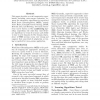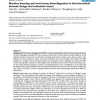150 search results - page 1 / 30 » Four Methods for Supervised Word Sense Disambiguation |
NLDB
2007
Springer
13 years 10 months ago
2007
Springer
Word sense disambiguation is the task to identify the intended meaning of an ambiguous word in a certain context, one of the central problems in natural language processing. This p...
CORR
2000
Springer
13 years 4 months ago
2000
Springer
This paper describes a set of comparative experiments, including cross{corpus evaluation, between ve alternative algorithms for supervised Word Sense Disambiguation (WSD), namely ...
BMCBI
2006
13 years 4 months ago
2006
Background: Word sense disambiguation (WSD) is critical in the biomedical domain for improving the precision of natural language processing (NLP), text mining, and information ret...
ACL
2004
13 years 6 months ago
2004
Supervised learning methods for WSD yield better performance than unsupervised methods. Yet the availability of clean training data for the former is still a severe challenge. In ...
ACL
2003
13 years 6 months ago
2003
In this paper, we proposed a new supervised word sense disambiguation (WSD) method based on a pairwise alignment technique, which is used generally to measure a similarity between...


